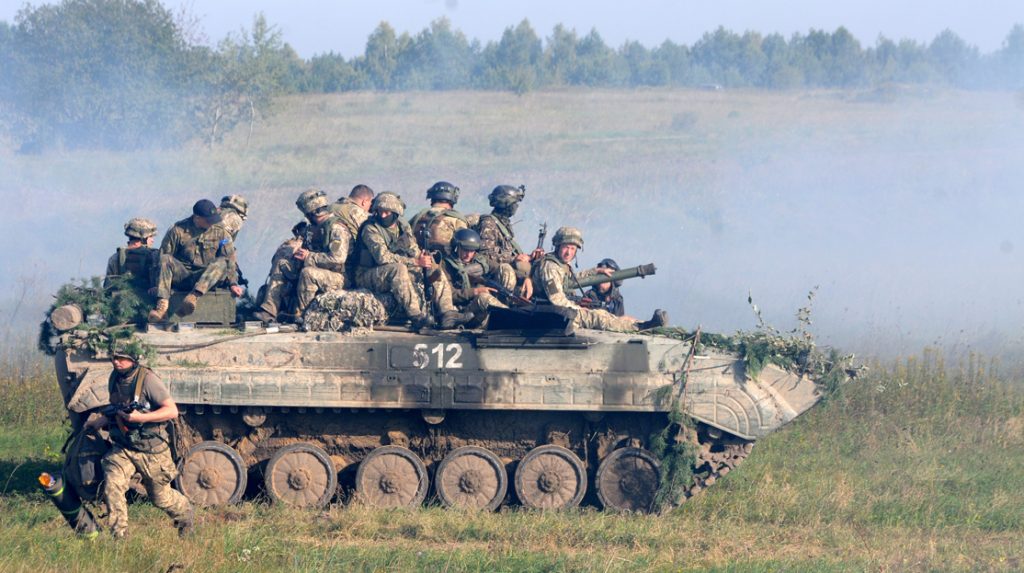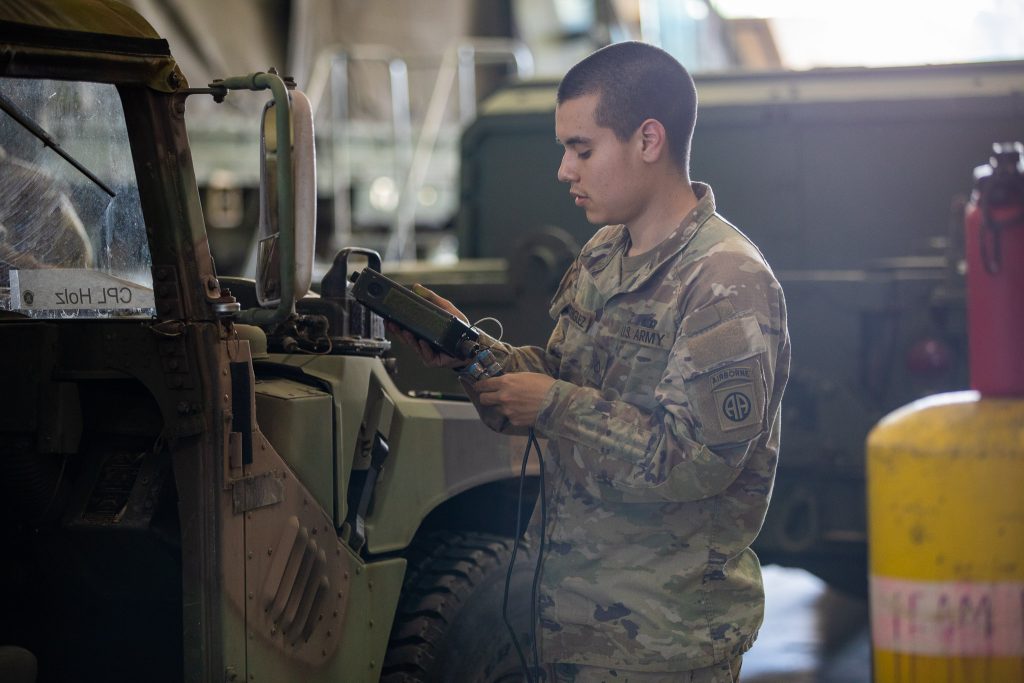
PARTNER NATIONS: Spc. Charles Ramirez, an infantryman assigned to 1st Battalion, 8th Cavalry Regiment, aims a simulated Javelin Anti-Tank System during Karelian Lock 23 on Pahkajarvi Training Area, Finland, May 30, 2023. Javelin systems have been part of the support sent to Ukraine. (Photo by Spc. Jacob Nunnenkamp, 2nd Armored Brigade Combat Team, 1st Cavalry Division Public Affairs)
ASA(ALT) actions to support Ukraine exemplify effort to build capacity at speed and scale.
by James Treharne, Ph.D., and James Stocks
It has been over a year since Russia invaded the sovereign nation of Ukraine in February 2022. The Army is a major part of a massive DOD effort, along with a large coalition of partner nations, to provide security assistance to Ukraine. The United States and its allies and partners remain steadfast in their commitment to support Ukraine and its fight for democracy, sovereignty and territorial integrity.
The mission of the Assistant Secretary of the Army for Acquisition, Logistics and Technology (ASA(ALT)) is to continuously modernize the Army, as part of the joint force, through rapid and timely delivery of Soldier capabilities that deter adversaries and win our nation’s wars. Each day, dedicated members of ASA(ALT), at both headquarters and program executive offices (PEOs), focus on ensuring that the enterprise seeks, develops, fields and sustains effective capabilities that provide unmatched advantage across the competition continuum. While delivering the Army of 2030 is the primary focus, ASA(ALT) is also a significant contributor to Army efforts to build the capacity and capability of allies and partners. The massive and rapid response to the Ukraine crisis provides an example of these efforts to build capacity at speed and scale.

TRAINING TANKS
Ukrainian troops move into position during the field training exercise portion of Rapid Trident, Sept. 12, 2018, at the International Peacekeeping Security Center near Yavoriv, Ukraine. (Photo by Staff Sgt. Ryan Sheldon, U.S. Army National Guard)
ROLLING OUT A RESPONSE
As of July 7, 2023, the United States has committed more than $42 billion in security assistance to Ukraine since the beginning of the Biden administration, including more than $41.3 billion since the beginning of Russia’s unprovoked and brutal invasion on Feb. 24, 2022. Some of the systems, vehicles and equipment include:
- 155 mm howitzers.
- High Mobility Artillery Rocket Systems and ammunition.
- High Mobility Multipurpose Wheeled Vehicles.
- Javelin anti-armor systems.
- Stryker armored personnel carriers.
- Abrams tanks.
For a complete and detailed list of support, please see the Ukraine fact sheet at defense.gov.
AUTHORITIES
To execute this important national security mission, ASA(ALT) relied on existing and expanded congressional authorities. The first was the Presidential Drawdown Authority (PDA). This authority allows the Army to deliver equipment by drawing from U.S. Army resources, such as an Army unit, including active duty, Reserve or National Guard. The Army could also draw from existing stocks or delivery orders on existing contracts. Using the PDA allows the Army to deliver equipment to Europe quickly.
The second authority ASA(ALT) leveraged was the Ukraine Security Assistance Initiative. This authority allows the Army to procure capabilities for Ukraine from industry. This generally presents less of a readiness impact, especially in the short term. However, the materiel may not be delivered for years because of production lead times. While this may not immediately affect their current operations, it sends a strong message of our government’s long-term commitment to supporting Ukraine.

READY FIRE
A paratrooper assigned to 3rd Brigade Combat Team, 82nd Airborne Division installs Multiple Integrated Laser Engagement System (MILES) gear on a Humvee at the Joint Readiness Training Center on Fort Polk, Louisiana (now Fort Johnson), April 19, 2023. MILES gear includes sensors that simulate the reception of enemy fire for training purposes. (Photo by Spc. Rognie Ortiz Vega, 49th Public Affairs Detachment)
SUCCESS AT SCALE
ASA(ALT) has both the experience and skillsets to execute the presidential drawdown process, but has not done so at the scale and speed of the current effort, which dwarfs previous efforts in terms of quantity, value and timelines for completion. Additionally, many assumed the initial surge efforts early in the conflict would be sufficient, but the pace and scope of the support has continued at a high level for over a year. Through the commitment and dedication of ASA(ALT)’s workforce, there have been several key reasons for the current success.
ASA(ALT) relies on strong, competent, innovative leaders from its headquarters down through its PEOs and program management offices, as well as from teammates across the Army. ASA(ALT) and Army Materiel Command are essentially performing their wartime mission to generate and sustain combat capability. Acquisition leaders received guidance while facing many unknowns and uncertainties and rapidly developed solutions to complex problems.
One of the most important enablers of success is the existing relationships that leaders, at all levels, have established and maintained across Army commands and staffs, as well as with their counterparts at higher and adjacent commands and staffs. These existing relationships based on streamlined communications, grounded in familiarity and trust, enable the Army to rapidly adjust to changing demands and compressed timelines.
While ASA(ALT) has much experience providing materiel support to partners and allies, the critical nature of Ukraine response required organizational agility and the formation of a dedicated rapid response team. ASA(ALT) headquarters formed a “smokejumper team.” Like those who fight wildfires, our smokejumpers were highly trained professional leaders of planning and action. They were formed with expertise across ASA(ALT) and included direct participation from PEOs and program offices as required. The team’s depth and breadth of acquisition, security assistance, sustainment, budgetary and financial expertise were essential to execute this mission. This team was given senior leader intent for execution and team members were empowered to make decisions to facilitate rapid planning. Teaming and agile leadership were instrumental to success in providing support to Ukraine.

HIMARS EXERCISE
A High Mobility Artillery Rocket System (HIMARS) from 3rd Battalion,197th Field Artillery Regiment, fires a Reduced Range Practice Rocket during a live-fire exercise at McGregor Base Camp, Las Cruces, New Mexico, April 15, 2023. (Photo by Spc. Devin Bard, 3-197th Field Artillery Regiment Public Affairs)
Clear channels of communication were essential within ASA(ALT) headquarters, as well as with PEOs and teammates in the Army G3/5/7, G8, Army Budget Office, Assistant Secretary of the Army for Financial Management and Comptroller and Army Materiel Command. The presidential drawdown process became a fast-paced, tense and rigorous two-week drill that required continual flow of information within the Army and to leadership in the Office of the Secretary of Defense. Success in the DOD enterprise was due largely to a well-managed battle rhythm among stakeholders and constant communications at multiple levels within the enterprise. Speed and tempo were dependent on collaborative multiagency relationships and direct access to, and frequent touch points with, senior leaders to facilitate rapid decision making.
A key challenge to the team was having good data to underpin key drawdown decisions. Ensuring the data was of sufficient quality was a constant issue and source of much effort. To be high quality, data must meet the VAULTIS goals: visible, accessible, understandable, linked, trustworthy, interoperable and secure. ASA(ALT) must continue to invest in expertise to ensure its workforce has the skills and tools to leverage data for decision making.
The COVID-19 pandemic highlighted the importance of a stable and robust organic and commercial industrial base. The Ukraine support has reinforced the fact that the Army’s military readiness depends on a healthy, responsive and modern defense industrial base. ASA(ALT) leadership has made the industrial base a strategic priority—with the full support of Congress, the Army is making substantial long-term investments in the industrial base. In the meantime, as the secretary of the Army and the chief of staff of the Army recently reported, “The Army is working closely with the Office of the Secretary of Defense and our industry partners to rapidly increase production capacity and transform our processes from vulnerable supply chains to a more resilient supply fabric.”
A key element of responsive to partner demand is ensuring we proactively manage technology security and export control measures to ensure we can provide meaningful capability to partners while maintaining our technological edge. Systems should be designed and built with the mindset that they will likely be exported to an ally or partner nation. This is not a new requirement, but it is often traded away when faced with cost and schedule constraints. However, in a crisis, exportability can become a critical limiting factor that even relatively unconstrained resources can solve in the timeline required…. time once traded can’t be reclaimed. Like building for reliability, the Army must design and build exportability features in from the beginning.
A key factor to success was the recognition that ASA(ALT) must operate within DOD established processes while ensuring its own internal processes for presidential drawdowns were efficient, effective, collaborative and transparent. ASA(ALT) worked on a two-week battle rhythm to receive, analyze and respond to DOD requests for materiel support. Coordination and approval processes operated on both unclassified and classified networks. At any given time, the Army was working on three different drawdown requests. ASA(ALT) continually refined its process and procedures to ensure requests were acted upon expeditiously and senior leaders were provided sufficient and timely analysis to support their decision making.
CONCLUSION
Over the last year, the Army acquisition enterprise has planned and executed their mission well to support Ukraine security assistance as a significant contributor to Army efforts to build capacity and capability due to the detailed planning, diligence and leadership of its workforce, while operating under tight timelines and resource constraints. As we continue to execute, ASA(ALT), and the broader Army enterprise, must institutionalize what has been learned; capture the appropriate information in policy and regulations; and, where appropriate, recommend statutory changes to ensure it remains strategically and operationally responsive to the needs of our nation.
For more information about ASA(ALT), go to https://www.army.mil/asaalt.
James Treharne, PH.D., serves as the director of acquisition studies and analysis with ASA(ALT) in the Deputy for Acquisition and Systems Management Office in the Pentagon. He is a retired Army engineer colonel and has a Ph.D. in industrial and systems engineering and an M.S. in industrial engineering from Auburn University, and a Master of Strategic Studies from the Army War College. He is a graduate from the United States Military Academy at West Point with a B.S. in applied science and engineering.
JAMES STOCKS serves as the deputy chief of operations, plans and strategy with ASA(ALT) in the Deputy for Acquisition and Systems Management Office in the Pentagon. He has served in multiple organizations at the ASA(ALT) headquarters and is a retired U.S. Marine. He has an M.S. in business administration from Boston University, an M.S. in national resource strategy from the Industrial College of the Armed Forces, and a B.S. in management from Guilford College.







